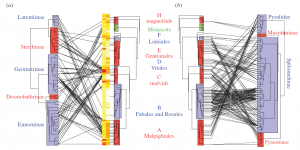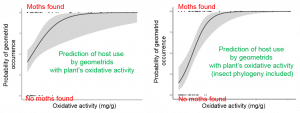Recent multidisciplinary project combined evolutionary history and plant chemistry to understand and predict the occurrence of herbivorous insects across rainforest plants. This study was published in the prestigious journal, Proceedings of the Royal Society B.

Figure 1. Co-phylogeny between (a) geometrid and (b) pyraloid caterpillars included in the data. Heat maps superimposed on the geometrid host phylogeny show observed abundance (left column) and the predicted probability of occurrence (right column).
Papua New Guinea is one of the few places on earth where one can find large areas of still untouched rainforest. In addition, the species richness in Papua New Guinea for both plants and herbivores is huge, suggesting that they share a long history of co-evolution. In a recent paper, Segar et al. (2017) examined the interplay between 122 plant species and 106 lepidopteran species. They used standardized food-web data, multigene phylogenies of both trophic levels and plant chemistry data to model interactions between Lepidoptera larvae (caterpillars) from two lineages (Geometridae and Pyraloidea) and plants in a species-rich lowland rainforest in New Guinea (Fig. 1 and 2). Model parameters were used to make and test blind predictions for two hectares of an exhaustively sampled forest.
Polyphenol oxidative activity (but not protein precipitation capacity) was important for understanding the occurrence of geometrids (but not pyraloids) across their hosts. When both foliar chemistry and plant phylogeny were included, Segar et al. 2017 predicted geometrid–plant occurrence with 89% concordance (Fig. 3).

Figure 3. The oxidative activity of plants measured by the Salminen & Karonen (2011) can be used together with the insect phylogeny to accurately predict the presence of geometrid moths on rainforest plants.
The model framework allowed Segar et al. (2017) to compare phylogenetic conservatism between two ecologically dominant Lepidoptera lineages. Their results give insights into the evolutionary hypotheses of host use, the contribution of conserved and labile traits, and the evolution of polyphagy both between and within species. It is unlikely that any of the evolutionary processes put forward can explain all insect herbivore diversity, but the types of predictive models presented help to test macroevolutionary hypotheses at the community level.
The study as a whole can be found at:

